The Checker Maven
The World's Most Widely Read Checkers and Draughts Publication
Bob Newell, Editor-in-Chief
Published every Saturday morning in Honolulu, Hawai`i
Noticing missing images? An explanation is here.
Eyes Only


WHITE
White to Play and Win
When you either have the solution, or have had enough, click on Read More to learn the winning way.
[Read More]A Little Summer Housekeeping

Also, our on-line publication calendar has gotten out-of-date. Look for us to get that fixed up within the next week or so.
Thank you for helping to make The Checker Maven one of the world's most-read checker publications.
Leo Is On The Team!
The Checker Maven is pleased to note that, following a period of controversy (see our previous editorial on this topic), eminent checker grandmaster Leo Levitt will be playing for the USA in the upcoming 100th Anniversary International Match with Great Britain.

Congratulations and thanks are due all around to those who in the end upheld the best principles of our game. We recall Dr. Martin Luther King's famed expression, "It's always the right time to do the right thing" and we are proud that our ACF leaders did exactly that.... the right thing.

Faster Than a Speeding --- Turtle?
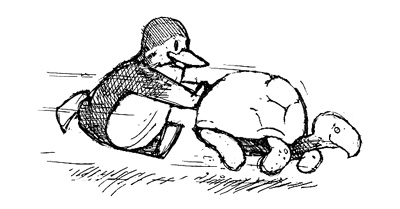
Toe up to the starting line and click below to display the problems and start the clock. Good luck! You can check your solutions by clicking on Read More. Afterwards, click here to cast your vote for the type of speed problems you prefer.
(This article has been edited subsequent to original publication due to valuable reader input. As a result you have three problems instead of two!)
Problem One (very hard for a timed problem)
Problem Two (medium difficulty, original erroneous diagram corrected)
Problem Three (quite hard, as originally published)
[Read More]A Small Change

So, in order to maintain consistency and predictability year-round, and to help manage our publication workload while still providing quality content, we're going to a permanent Saturday-morning schedule. We're dropping our Wednesday editions in favor of providing more on Saturdays.
This means that during summer and holiday periods, you'll still see a weekly Saturday article. During the regular parts of the year, you'll see at least one article and possibly two or three, as our time, energies, and backlog allow.
We hope this small change will prove pleasing, and invite your comments.
In the Grand Manner
We spent a pleasant interval at our Honolulu office, where we made quite a bit of progress on our "electronic classics" projects. But now we're back in Santa Fe, and, lo and behold! The Santa Fe Opera performance season is in full swing!
Along with the Grand Old Game, there is little that is as wonderful as Grand Opera, performed by a truly world class company such as we are privileged to have here in Santa Fe.
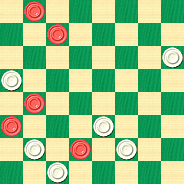
White
White to Play and Win
Just a word of caution: today's problem is "grand" in terms of difficulty as well as content. If you solve it, congratulations --- you might wish to reward yourself with a front row seat at the Santa Fe Opera!
[Read More]The Checker Maven is Looking for Stringers
One of the most asked-for items in our recent user survey was annotated games from recent events. We've earlier remarked that delivering on this will not be easy, and so we're looking for volunteer "stringers" among our readership and elsewhere.
Now, we know that up-to-the-minute tournament results and standings are generally posted on the Checker Solutions BBS (see link at left), or on specific websites. We're not looking to compete or "double up" in this area, and we're not looking to publish games, play, or analysis without proper permissions and clearances. We know that in a number of cases, game scores are kept in reserve for contributors.
However, having said all that, if you're in a position to provide us with timely news, play, or commentary from checker events, and doing so wouldn't be in conflict with what we've stated above, your contributions would be heartily welcomed. Full credit would be given, and in return you can have any share you want of our subscription fees. (Let's see, we learned in school that any number times zero is ....)
We hope to hear from you!
Welcome to Checker School
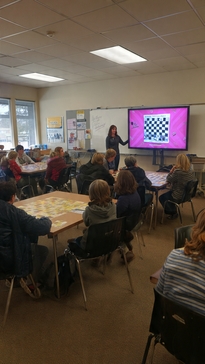
Our May Checker Maven Reader's Survey demonstrated to us the popularity of our electronic republications of classic checker literature, and contained suggestions to publish more as time permits. In response to these requests, we're inaugurating a new series that we're calling Checker School. This will, over time, amount to new electronic editions of Ben Boland's classics Famous Positions in the Game of Checkers, and Familiar Themes. These are seminal works that prove as valuable today as they did when they were published over six decades ago. Now, these books contain much complex material, so a complete reissue will likely take many months if not years, but we're working at it!
Let's get started with a delicate endgame of a very practical nature. Class is in session!
WHITE
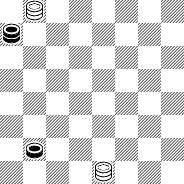
BLACK
Black to Play and Draw
Click on Read More for the solution, a runup to the position, and additional notes and quotes from Famous Positions.
(Editor's Note: the color diagrams will return as soon as we work through our article backlog.)
[Read More]Three Easy Strokes, Part Three
Here's the last of our "easier" stroke problems, at least in this series. Will you find this one to be a July cruiser, or something more? Solve it, check your solution by clicking Read More, and then prepare yourself --- next month's problem is going to be a summer scorcher.
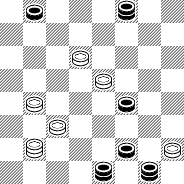
WHITE
White to Play and Win
Two Easy Pieces: Sixth Edition
Willie Ryan's classic Tricks Traps & Shots of the Checkerboard, presented here in a new electronic edition, is up to the sixth installment. Here's what Willie has to say on page 16 of the book.
BLACK
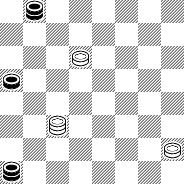
WHITE
White to Play and Win
BLACK
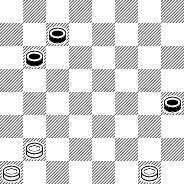
WHITE
White to Play and Win
You can check your solutions by clicking on Read More.
[Read More]The Checker Maven is produced at editorial offices in Honolulu, Hawai`i, as a completely non-commercial public service from which no income is obtained or sought. Original material is Copyright © 2004-2026 Avi Gobbler Publishing. Other material is public domain, AI generated, as attributed, or licensed under CC1, CC2, CC3 or CC4. Information presented on this site is offered as-is, at no cost, and bears no express or implied warranty as to accuracy or usability. You agree that you use such information entirely at your own risk. No liabilities of any kind under any legal theory whatsoever are accepted. The Checker Maven is dedicated to the memory of Mr. Bob Newell, Sr.



